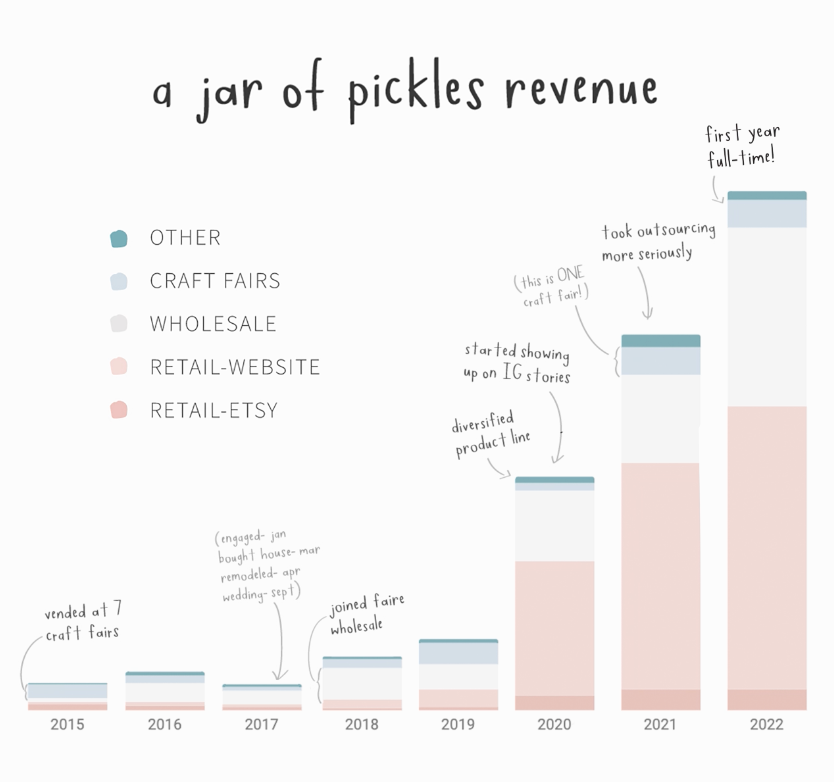
How I Grew a $200 Side-Hustle Etsy Shop Into a Multi-6-Figure Business
Kirstie Wang never planned on her side hustle becoming her full-time job, but a few key approaches led to unexpected growth in her business.
Founder of A Jar of Pickles
My business started off as a small, experimental project nearly a decade ago. I had a lot of free time between graduating from college a semester early and starting my full-time job, where I'd eventually pursue a career in design and marketing in the tech world. I was known for constantly doodling on Adobe Illustrator in class, and one of my friends suggested I try and sell some of my designs on Etsy. So I did.
The early version of my store, A Jar of Pickles, was very low budget. I only sold greeting cards because they were the lowest barrier to entry, and I didn’t even hold inventory, instead going to the office supply store every Friday night to print the handful of orders I had gotten that week.
About a year in, I was seeing consistent enough sales that I decided to invest about $200 in buying some cards and envelopes in bulk (to improve my margins from printing on demand), some equipment to help me fold cards faster, and some packaging and shipping supplies.
From there, my business growth snowballed, slowly and steadily at first and then very suddenly. In 2020, we hit six figures in annual revenue. In 2021, I hired my first real employee and have since added two more. And, in 2022, I finally decided to put aside my corporate career and go full-time on the business.

Some of this growth was definitely a happy accident, but some of it was thanks to a few pivotal decisions I made along the way. Read on to learn the milestones and mindsets that have helped my business succeed, and how you can apply them to your own growing venture.
I found my own approach to wholesale (and every other business goal)
Almost everyone who makes physical products wants to see their products in a storefront—it’s validating and a great way to reach new audiences. So, once I was getting consistent sales on Etsy and started to think about my next business goals, wholesale was pretty quickly on the table.
I knew nothing about wholesale, so I turned to Google University, looked for resources online from other business owners, and took a course to learn more about trade shows. A lot of other businesses in my industry build their income around doing three or four trade shows a year and getting into big stores like Nordstrom or Target. And while being in those stores sounded cool to me, going to trade shows did not. I was still working full-time and would have to take PTO days to go to trade shows—days I would rather save for, you know, actual vacation.
So, I considered the options and found a more realistic approach, given my situation and values. I decided to aim for smaller boutiques, cold pitching retailers via email, and spend the rest of my energy focusing on direct-to-consumer sales. I spent a good year or two learning a lot about wholesale, and now I feel like we have a good system of reaching out to retailers and getting into stores pretty consistently.
By establishing these relationships early on, we’ve been able to grow our businesses together, and I’ve seen incredible gains from these smaller wholesale accounts. Plus, the traction and lessons we gained from them made it much easier to land bigger stores down the line: One of our newest, coolest retailers is the SF MOMA, which I don’t think I would have been able to achieve years ago.
This process of learning about big goals, experimenting, and breaking them down into something more manageable has guided so much of our business growth, from establishing our craft fair strategy to figuring out manufacturing to hiring. It can feel like everything needs to happen so fast when you’re building a business, but that can quickly lead to burnout, high spending you can’t keep up with, and generally feeling overwhelmed. Building a company is a marathon, not a sprint, and setting realistic and strategic goals with a long-game vision has been key for me.
I started posting consistently on Instagram Stories (and building the rest of my marketing around it)
I think Instagram Stories is one of the most underutilized business tools on social media, and that is a hill I will die on.
I loved Instagram Stories from the moment they launched for the fact that they were short-lived, which released a lot of the pressure to get the content exactly right and allowed me to be much more experimental. When I really committed to showing up on Stories in 2020, my engagement on Instagram more than tripled, and 96 percent of my website traffic came from Instagram alone. Stories are the perfect way to build a direct relationship with my customers and rapidly test content ideas, both of which inform every other aspect of my marketing.
Here’s how my Instagram Story strategy works: I show up nearly every day on my Stories and create my content live. I don’t plan anything in advance; I simply post what I’m doing, whether it’s behind-the-scenes footage of running my company to random life events that have nothing to do with my products but are still building my brand. Every few weeks, I take a look at my analytics to see what’s resonating (the number of shares is one of my favorite key performance indicators). Then, I use this information to plan longer-form content, like Reels, ads, YouTube videos, and email newsletters, thinking creatively about ways to tie this content back to my product to drive conversion.
For example, one story about a Trader Joe’s sunscreen I love that I thought was a great dupe for a more expensive product received a huge amount of engagement. I made a longer Reel about that sunscreen and sun protection in general, and at the end marketed our hats, which led to a nice bump in hat sales that week.
Maybe it’s not Instagram Stories for your business, but I encourage founders to find a low-pressure channel where they can easily show up regularly and test ideas. I promise it will make everything else about marketing your business easier (and way more fun!).
I diversified my product line when my customers asked for it (and when I could afford it)
For the first three years, I only sold paper goods like greeting cards and prints. Many businesses like mine expand product categories much more quickly to grow their sales. And while my revenue did nearly triple when I finally added items like enamel pins, keychains, and washi tape in 2020, I’m glad I waited to make this step.

For one, waiting allowed me to only add the products that my customers were actually asking for. Manufacturing some of the products we make now—like plushies and apparel—is complex and extremely capital-heavy. I didn’t want to go through all of that without knowing there was demand. Plus, by making products only after enough people voiced enough interest in them, customers felt heard and brought along for the journey. Our reorder rate is very high, hovering around 52 percent, and that’s definitely because of how we respond to customer desires in our product line and keep them updated by sharing consistently on Instagram.
But, perhaps most importantly, I only expanded my product line when the revenue from my business could support it. If I wanted to make a really cool product and it was going to cost $5,000 in investment to do so, I figured out how to make $5,000 in profit before moving forward with that dream product, which has always kept my business extremely profitable and cash flow very manageable, even during a year where online sales have significantly dipped across the board.
This has always been an important principle for me: I know many entrepreneurs would give anything to grow their business and take on loans or invest their own money to expand faster. But I have never been willing to do that.
Sure, you could argue this has slowed my growth. But I’ve worked with so many small businesses in my coaching who try to scale quickly by investing more than they have. What happens is their overhead gets higher and higher, and their margins never quite make it, but they think if they keep going that route, they’ll eventually get the profit to make up for it.
While this business strategy can work, my slower growth allowed me to do things my way, feel less pressure, and build a business that is not only successful but gives me the freedom to enjoy my life.
Try Buffer for free
140,000+ small businesses like yours use Buffer to build their brand on social media every month
Get started nowRelated Articles

Sending ads by mail may seem like a thing of the past, but this marketer thinks it’s a surprisingly effective approach for e-commerce brands.

In this article, get answers to questions about social media for solopreneurs.

Earth Day is one of the (many) days when businesses can create or reaffirm a commitment to practicing sustainability. Here are some ideas for small businesses looking to highlight Earth Day on Instagram.